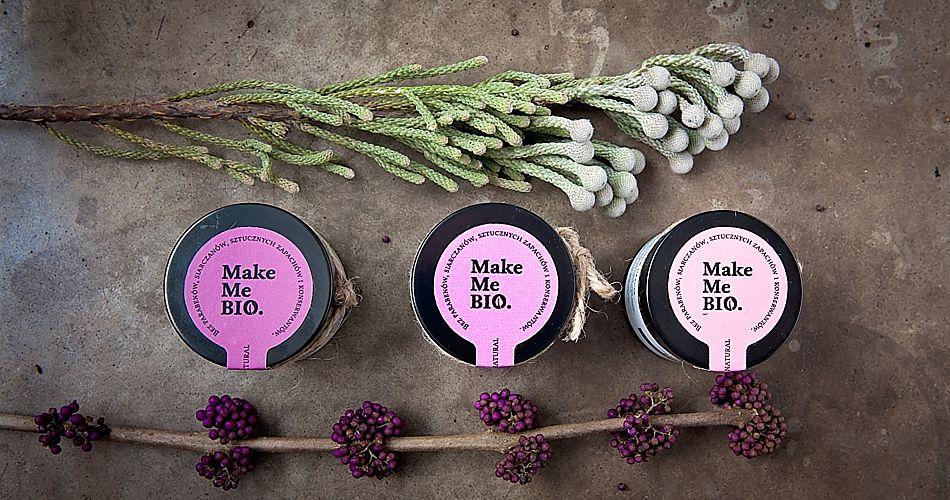
Because cosmetics come into direct contact with the human body, they are one of the most thoroughly examined group of products on the market. Any new controversy regarding a particular ingredient of a preparation leads to a series of tests and restrictions. Customers’ concerns contribute to the dynamic development of the bio cosmetics sector. Yet, since their regular counterparts undergo such a thorough examination, are they really worth using?
Have cosmetics always been good for health?
In the past, cosmetics comprised a mixture of natural, plant-derived and animal-derived ingredients, but were not necessarily good for health. As production lines and the chemical industry have been developing, the price of cosmetics started to fall. Yet what also followed was a replacement of the ingredients used previously with their synthetic counterparts.
ECO, BIO, NATURAL or ORGANIC?
These days, there is a wide choice of products referred to as ECO, BIO, NATURAL and ORGANIC. One of the most significant differences between BIO and ECO products is the amount of natural products they contain. BIO products must contain a minimum of 95% of natural products, whereas in the case of ECO products the standards are not as strict. The main feature of the production process of eco cosmetics is that it is environmentally-friendly. The same standards are required in bio cosmetics, but on top of that their ingredients are also fully natural and come from plantations that are subject to stringent norms. What is more, close attention is paid to the quality of manufacturing and ecological packaging, whereas animal testing is strictly forbidden.
How to make sure a product is good quality?
In order to verify whether a given product is BIO or ECO we have to find a certification symbol on the packaging. Certification may be granted by many institutions, such as BDIH, the Soil Association or AIAB, but it is the ECOCERT certificate that is the most popular and highly reliable. It guarantees that a given product has at least 95% of natural ingredients and requires from the producer to set a new production line for BIO cosmetics. The certification body also controls the detergents used to clean the place of production, plantations which supply the raw material, the quality of the soil, as well as the conditions of the products’ transportation.
Continuous development of the BIO products market
The first BIO cosmetics were produced in the 1970s, but it was only in the second half of the 1990s that the production and sales of such products began to grow. In 2010 the world’s bio cosmetics market was valued at 9.4 billion dollars. Only five years later its value increased more than fourfold! According to the research conducted by the Allied Market Research, the market’s value is going to increase continuously. It is estimated that in the years 2014-2020 the ECO and BIO cosmetics industry will grow by 9.8%. By comparison, the development of the traditional cosmetics sector will reach only half of that rate. In relation to the whole cosmetics industry market, BIO and ECO sectors have the largest share in developed countries with the USA, Germany, the UK, Italy and France at the top of the list.
Why did we start to use bio cosmetics?
When in 2004 traces of parabens were detected in organisms of several women with breast cancer it turned out that they were absorbed through their skin. Soon after, it was reported that parabens have similar effect to oestrogens and were therefore said to be one of the factors responsible for male infertility. The blame was on the producers, who quickly started to phase out the dangerous parabens. The easiest way to avoid these kinds of ingredients in cosmetics is to buy products labelled with the ECOCERT symbol, because companies that use dangerous parabens, mineral oil, liquid paraffin, silicones, artificial colouring, synthetic aromatics and alkaline anions are not allowed to use the emblem.
Facts and myths
There are several myths about bio cosmetics. One of them is that contrary to traditional cosmetics, bio cosmetics do not cause allergic reactions. The truth is that both groups contain substances which may cause allergic reactions in some people. Another myth is that if bio cosmetics are healthy, other cosmetic products are not. Since cosmetics are one of the most thoroughly examined group of products on the market, this statement simply cannot be true. Any ingredients that could be potentially harmful for people’s health are not approved for use.
Are bio cosmetics a good investment?
The success of bio cosmetics in the 21st century is hardly surprising. It somehow corresponds to the growing popularity of the so-called “slow” lifestyle and to the growing interest in sports and eating healthily. However, producers should bear in mind that it is not only the label BIO, ECO or NATURAL that guarantees success. Since consumers pay more and more attention to products’ labels, producers investing in biocosmetics should first and foremost take care of a reliable certification on their products. Such certification, as well as honest information for the client about the production process and products’ quality, increases the chances that, in the course of next couple of years, the investment in bio cosmetics will be financially rewarding.
Powrót do listy artykułów











